
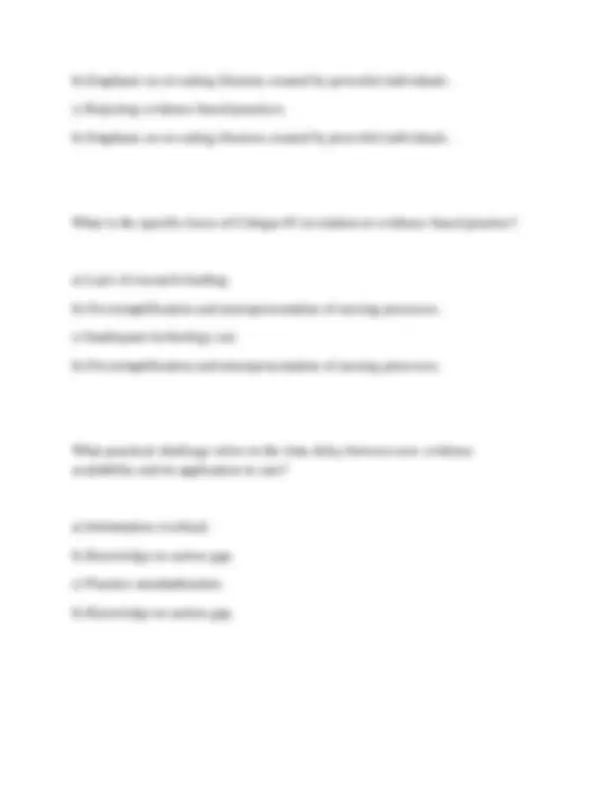
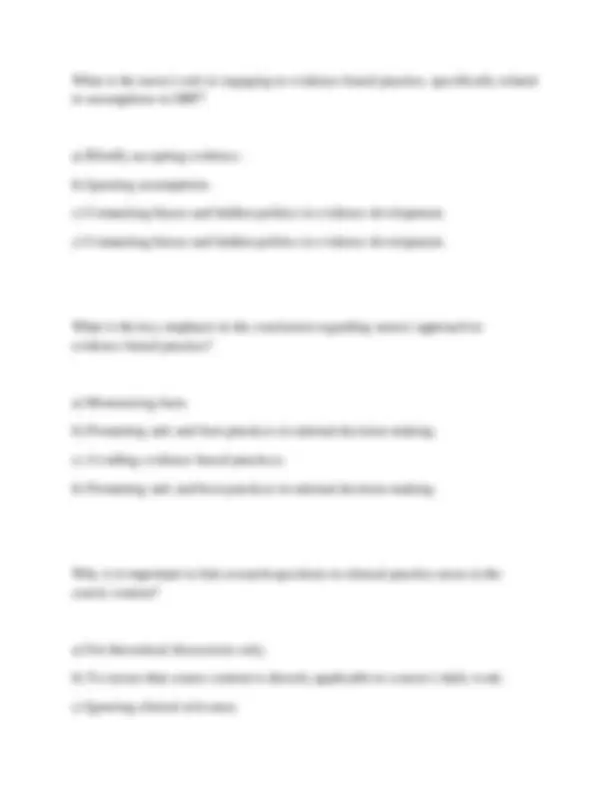
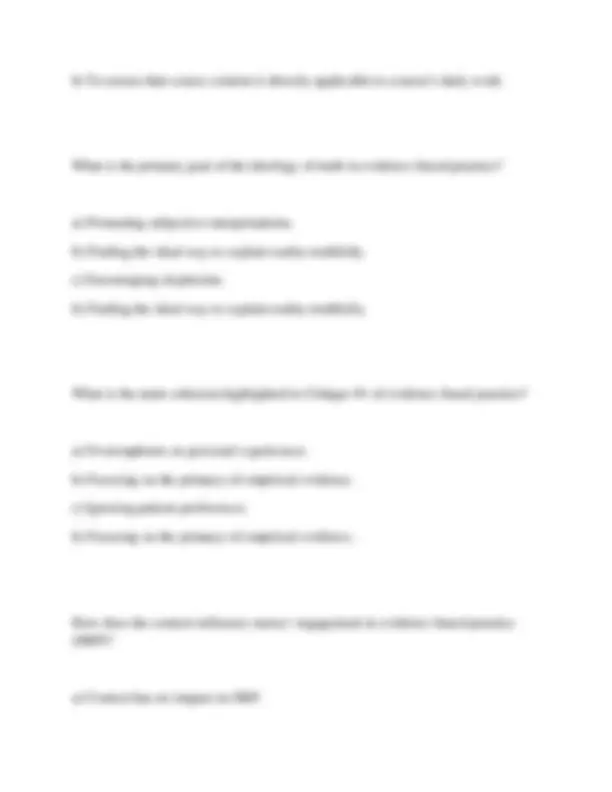
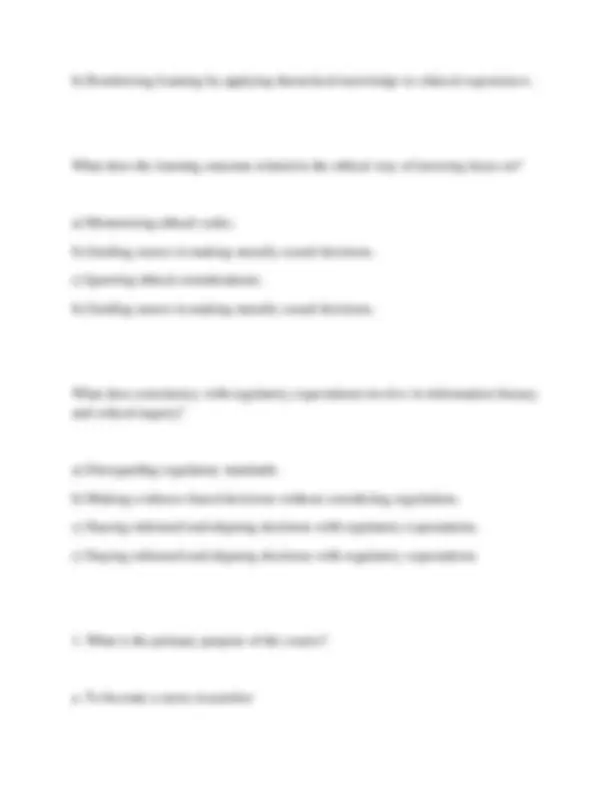

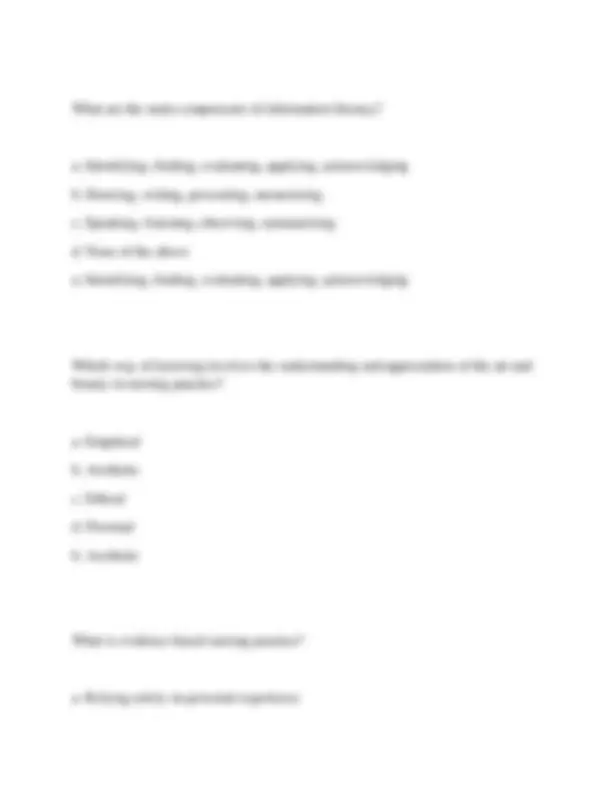
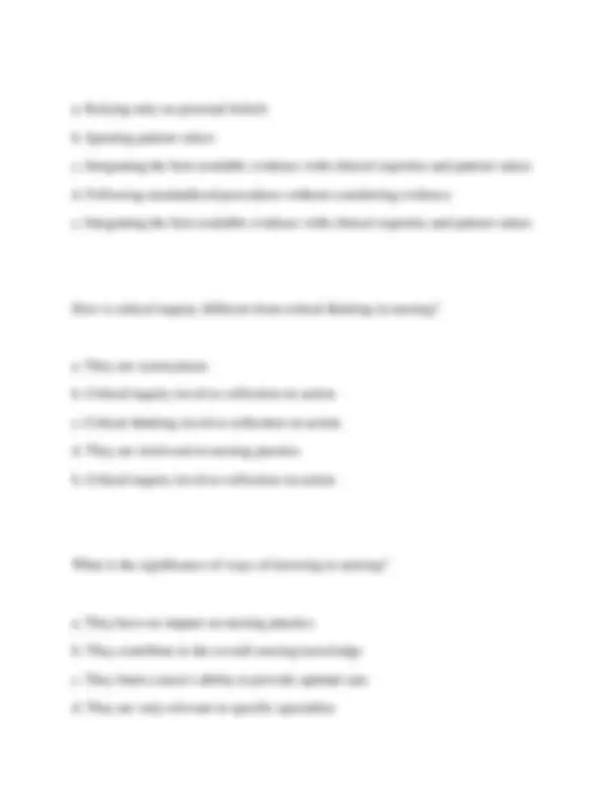
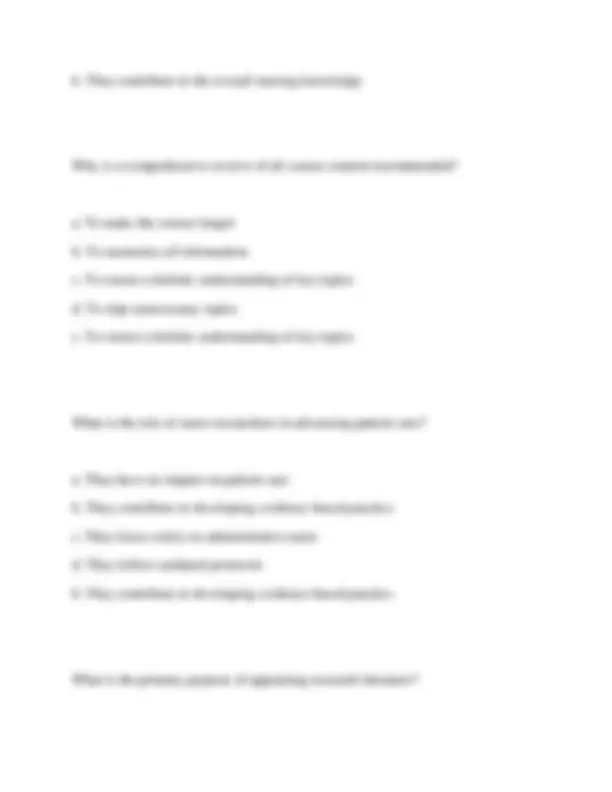
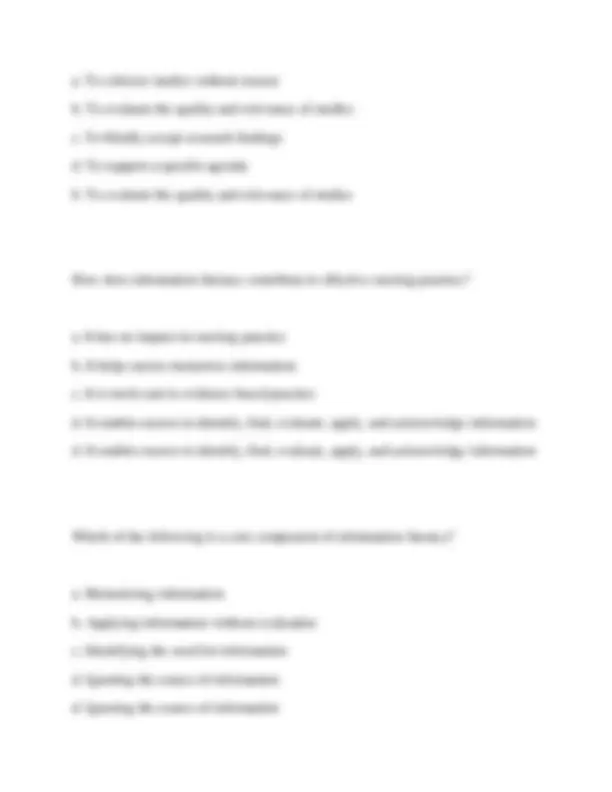
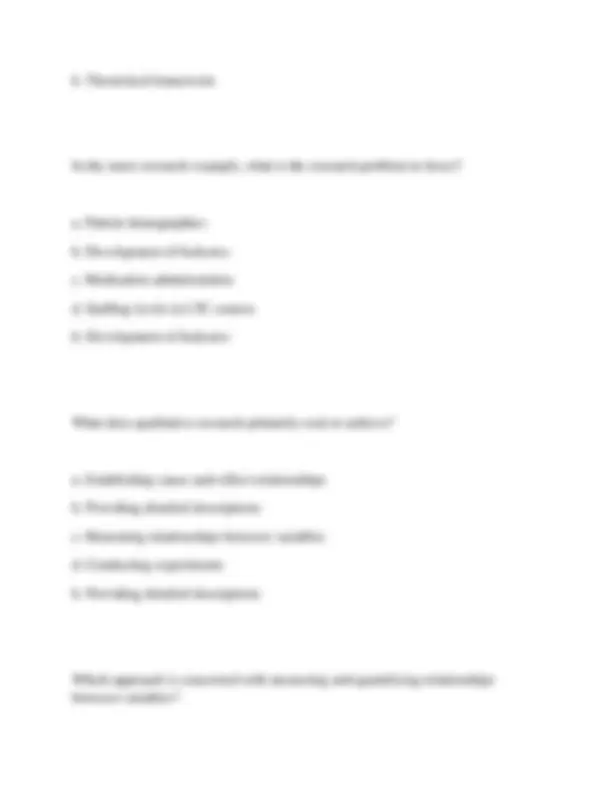
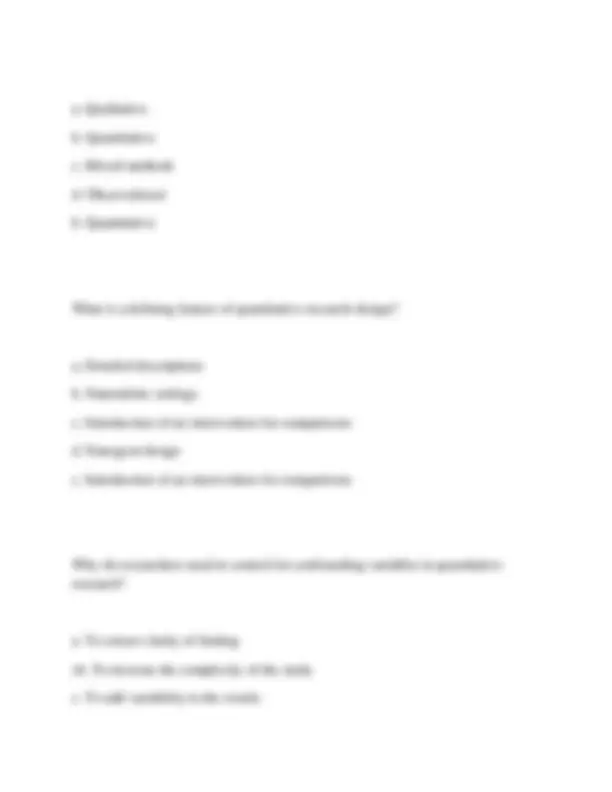
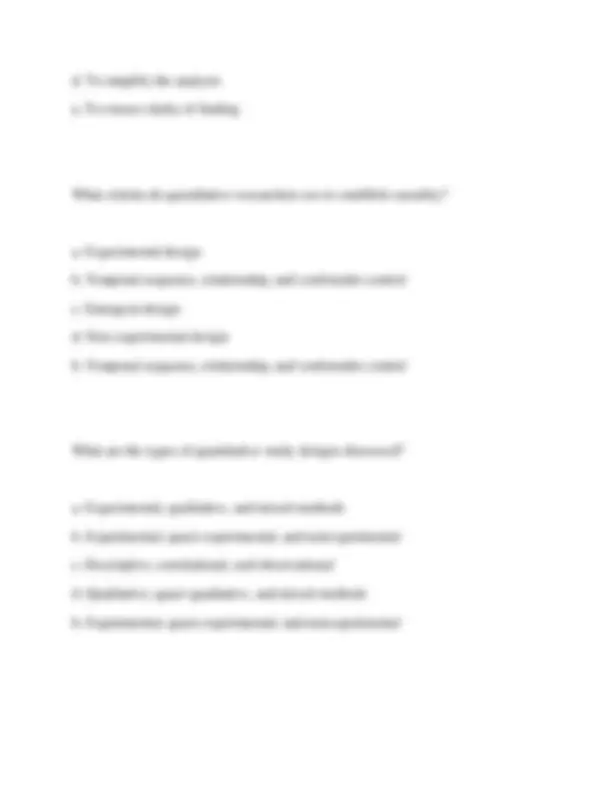
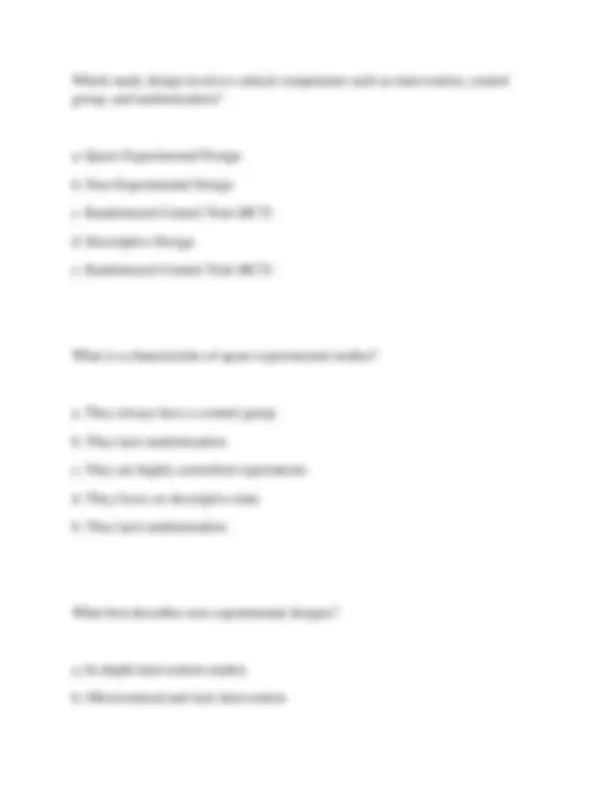
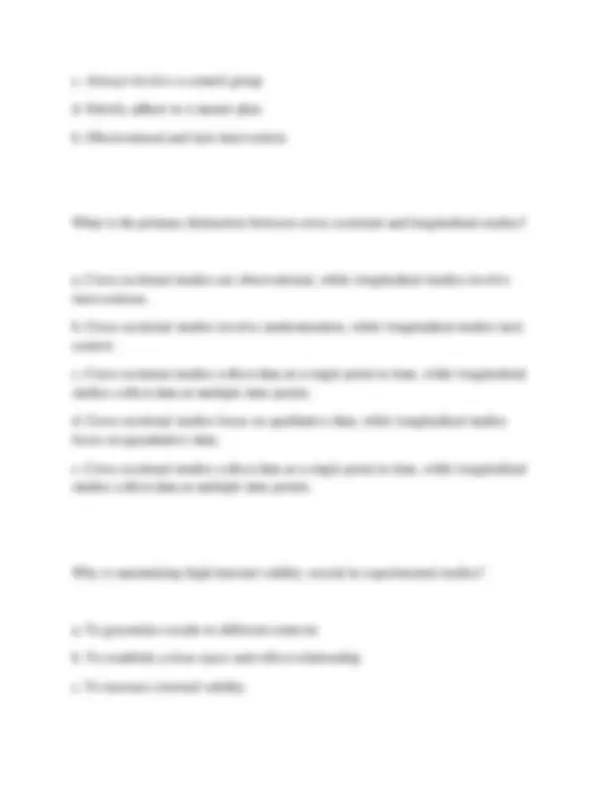
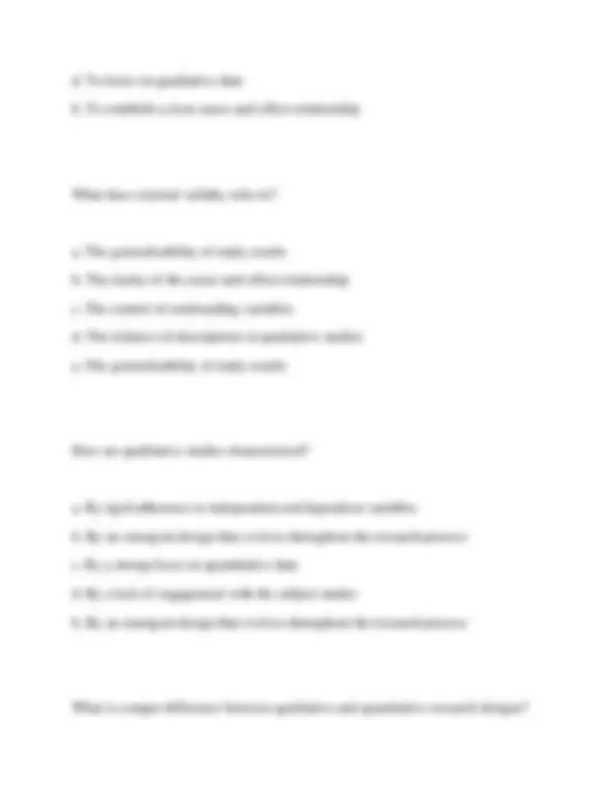
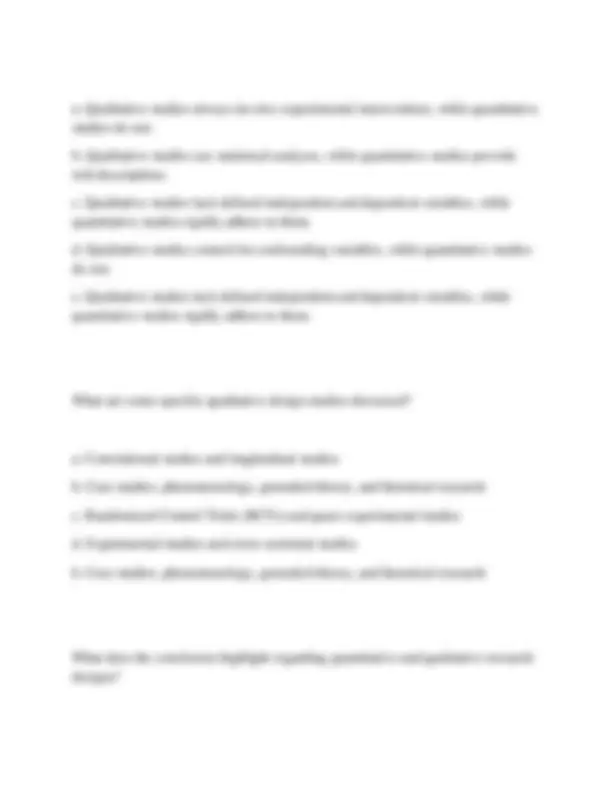
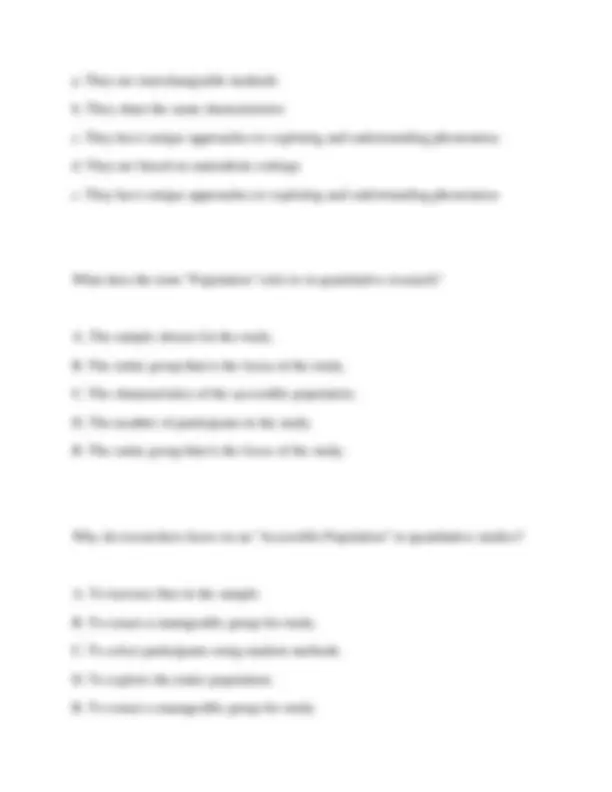
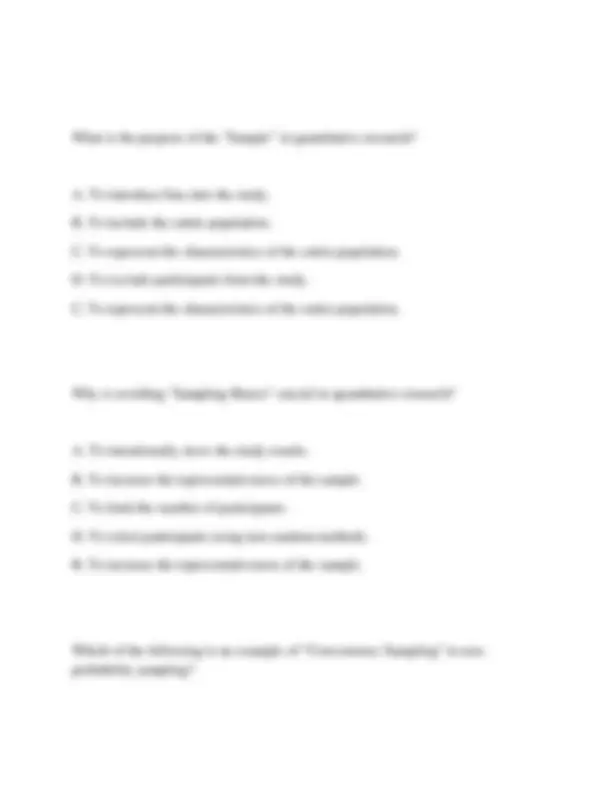
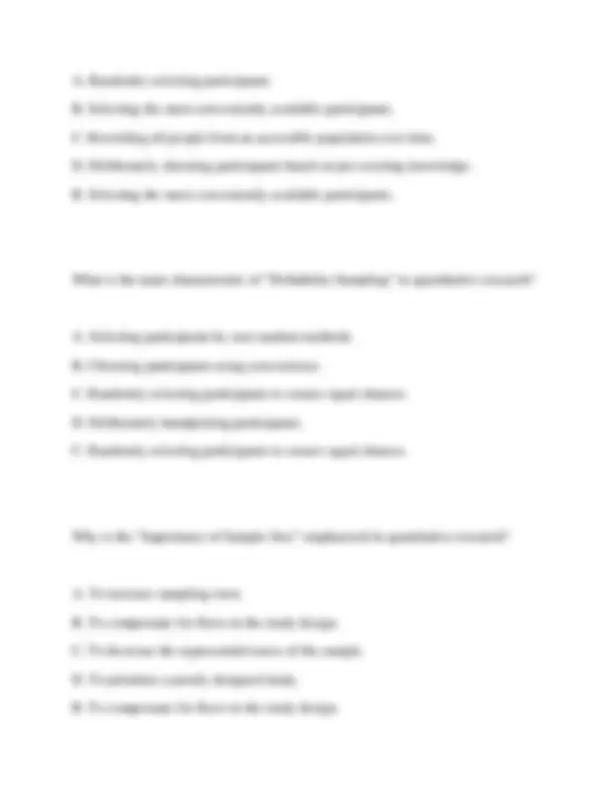
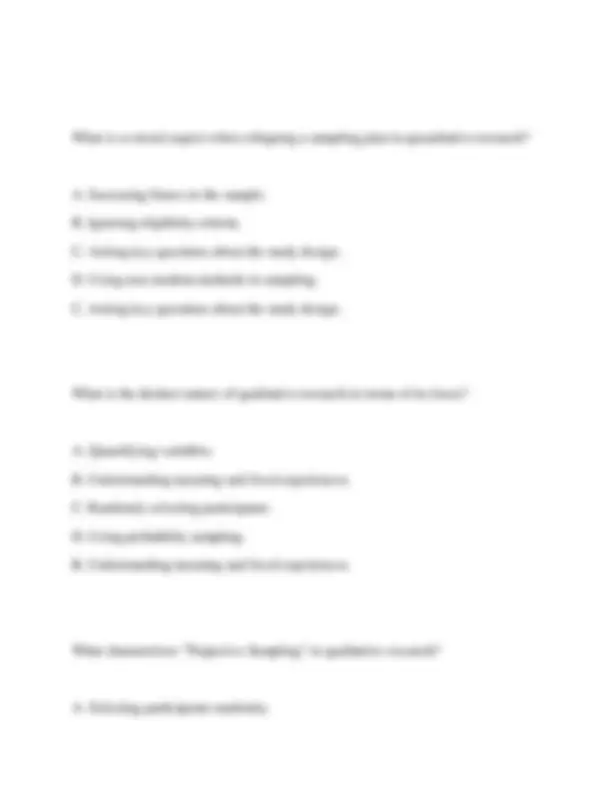
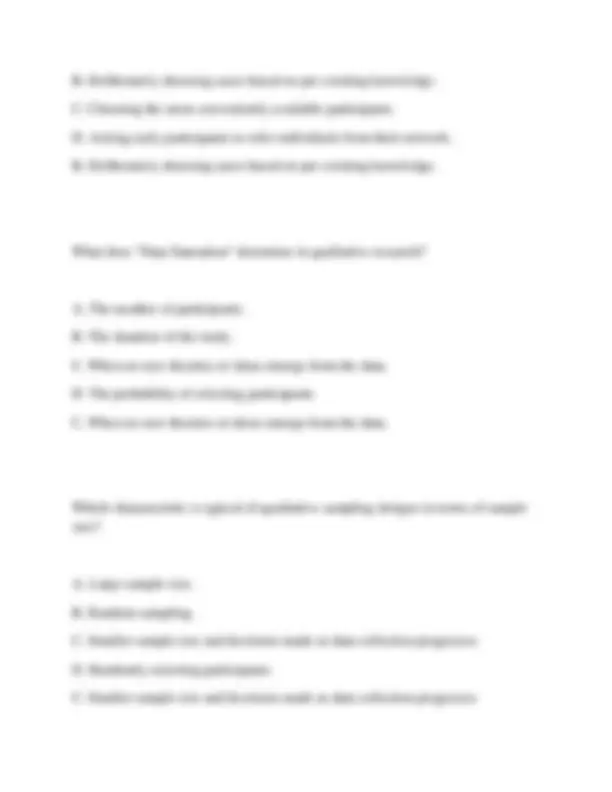
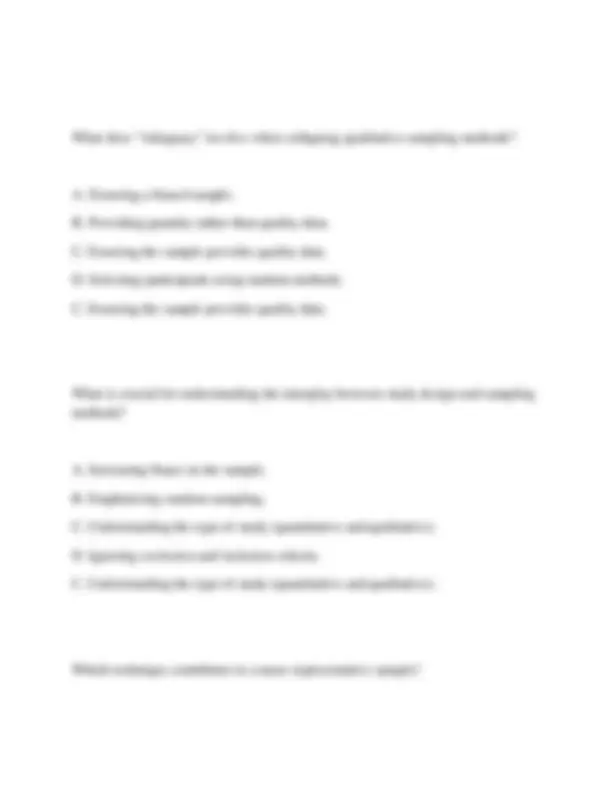
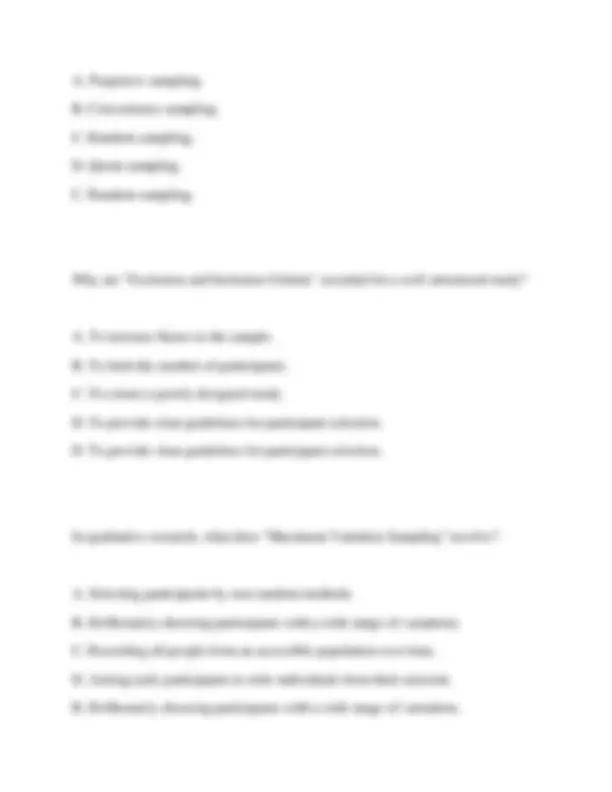
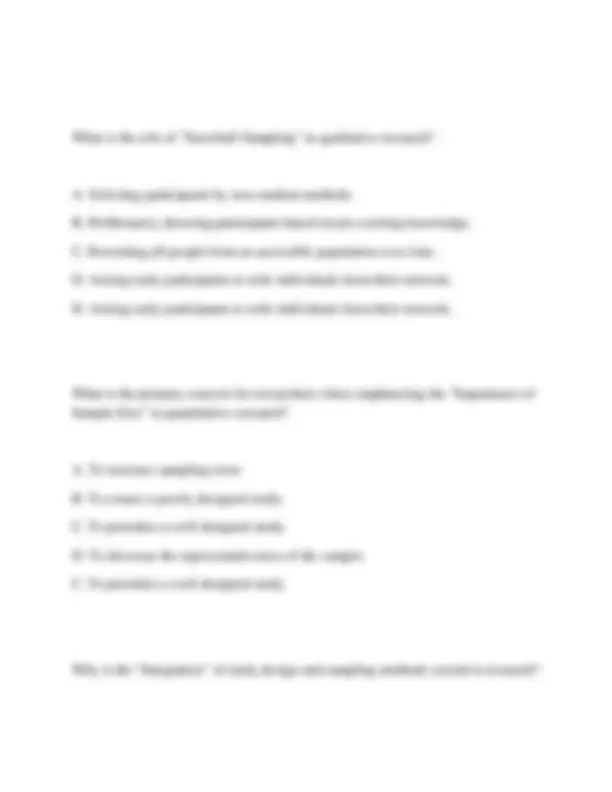
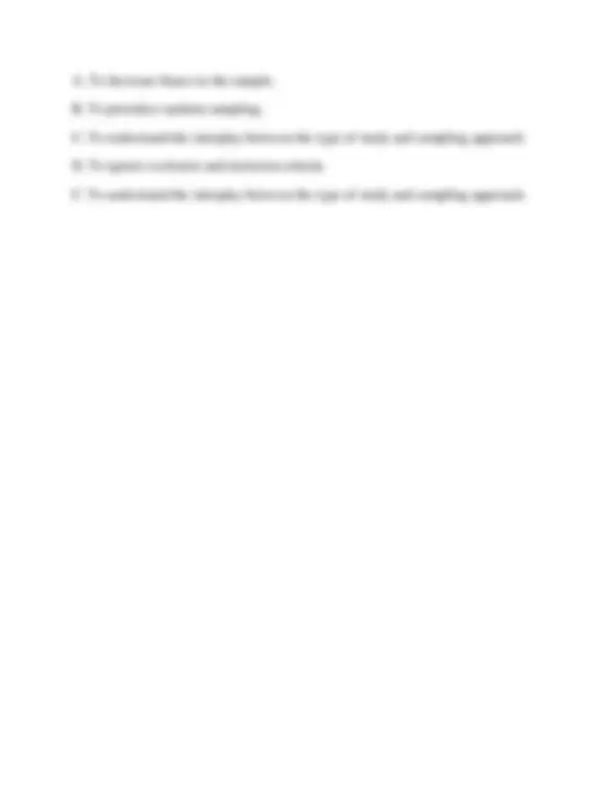


Study with the several resources on Docsity

Earn points by helping other students or get them with a premium plan


Prepare for your exams
Study with the several resources on Docsity

Earn points to download
Earn points by helping other students or get them with a premium plan
Community
Ask the community for help and clear up your study doubts
Discover the best universities in your country according to Docsity users
Free resources
Download our free guides on studying techniques, anxiety management strategies, and thesis advice from Docsity tutors
NSGD 3216 WEEK 1- 4 RESEARCH LATEST QUESTIONS AND CORRECT ANSWERS GRADED A+ NSGD 3216 WEEK 1- 4 RESEARCH
Typology: Exams
1 / 33

This page cannot be seen from the preview
Don't miss anything!


























Why is it important to recognize the role of research in a lifelong nursing journey?
a) To appreciate historical developments in nursing.
b) To stay updated with the latest evidence for optimal care provision.
c) To memorize research methodologies.
b) To stay updated with the latest evidence for optimal care provision.
What does the course content primarily aim to achieve in relation to the research process?
a) Memorizing research jargon.
b) A comprehensive understanding of research process components.
c) Focusing solely on qualitative research.
a) Memorizing research jargon.
What does the learning outcome related to the aesthetic way of knowing focus on?
a) Understanding statistical analyses in research.
b) Appreciating the art and beauty in patient care.
c) Identifying ethical dilemmas in nursing.
b) Appreciating the art and beauty in patient care.
What is the suggested approach for establishing a foundation for critical thinking and exploration?
a) Skimming through readings.
b) Ignoring required readings.
c) Completing required readings.
c) Completing required readings.
What is the key focus of the ideology of individual emancipation in relation to evidence-based practice?
a) Promoting conformity to authority.
What is the nurse's role in engaging in evidence-based practice, specifically related to assumptions in EBP?
a) Blindly accepting evidence.
b) Ignoring assumptions.
c) Unmasking biases and hidden politics in evidence development.
c) Unmasking biases and hidden politics in evidence development.
What is the key emphasis in the conclusion regarding nurses' approach to evidence-based practice?
a) Memorizing facts.
b) Promoting safe and best practices in rational decision-making.
c) Avoiding evidence-based practices.
b) Promoting safe and best practices in rational decision-making.
Why is it important to link research questions to clinical practice areas in the course content?
a) For theoretical discussions only.
b) To ensure that course content is directly applicable to a nurse's daily work.
c) Ignoring clinical relevance.
b) To ensure that course content is directly applicable to a nurse's daily work.
What is the primary goal of the ideology of truth in evidence-based practice?
a) Promoting subjective interpretations.
b) Finding the ideal way to explain reality truthfully.
c) Encouraging skepticism.
b) Finding the ideal way to explain reality truthfully.
What is the main criticism highlighted in Critique #1 of evidence-based practice?
a) Overemphasis on personal experiences.
b) Focusing on the primacy of empirical evidence.
c) Ignoring patient preferences.
b) Focusing on the primacy of empirical evidence.
How does the context influence nurses' engagement in evidence-based practice (EBP)?
a) Context has no impact on EBP.
What is the primary focus of identifying key concepts in evidence-based nursing practice?
a) Memorizing research jargon.
b) Integrating evidence with clinical expertise and patient values.
c) Ignoring clinical relevance.
b) Integrating evidence with clinical expertise and patient values.
Why is it important to appreciate nurse researchers' efforts in the course?
a) Historical significance.
b) Acknowledging their role in developing evidence-based practice.
c) Disregarding their contributions.
b) Acknowledging their role in developing evidence-based practice.
What is the purpose of engaging in a reflective activity in the suggested learning approach?
a) Memorizing facts.
b) Reinforcing learning by applying theoretical knowledge to clinical experiences.
c) Avoiding critical thinking.
b) Reinforcing learning by applying theoretical knowledge to clinical experiences.
What does the learning outcome related to the ethical way of knowing focus on?
a) Memorizing ethical codes.
b) Guiding nurses in making morally sound decisions.
c) Ignoring ethical considerations.
b) Guiding nurses in making morally sound decisions.
What does consistency with regulatory expectations involve in information literacy and critical inquiry?
a) Disregarding regulatory standards.
b) Making evidence-based decisions without considering regulations.
c) Staying informed and aligning decisions with regulatory expectations.
c) Staying informed and aligning decisions with regulatory expectations.
a. To become a nurse researcher
What are the main components of information literacy?
a. Identifying, finding, evaluating, applying, acknowledging
b. Drawing, writing, presenting, memorizing
c. Speaking, listening, observing, summarizing
d. None of the above
a. Identifying, finding, evaluating, applying, acknowledging
Which way of knowing involves the understanding and appreciation of the art and beauty in nursing practice?
a. Empirical
b. Aesthetic
c. Ethical
d. Personal
b. Aesthetic
What is evidence-based nursing practice?
a. Relying solely on personal experience
b. Integrating the best available evidence with clinical expertise and patient values
c. Ignoring patient values
d. Following outdated protocols
b. Integrating the best available evidence with clinical expertise and patient values
What is critical inquiry in nursing?
a. Memorizing information
b. Reflecting on action
c. Avoiding decision-making
d. Following orders without questioning
b. Reflecting on action
What is the importance of distinguishing between primary and secondary sources in research?
a. Secondary sources are always more reliable
b. Primary sources are not useful
c. To conduct effective research reviews
d. Both a and b
c. To conduct effective research reviews
a. Relying only on personal beliefs
b. Ignoring patient values
c. Integrating the best available evidence with clinical expertise and patient values
d. Following standardized procedures without considering evidence
c. Integrating the best available evidence with clinical expertise and patient values
How is critical inquiry different from critical thinking in nursing?
a. They are synonymous
b. Critical inquiry involves reflection on action
c. Critical thinking involves reflection on action
d. They are irrelevant in nursing practice
b. Critical inquiry involves reflection on action
What is the significance of ways of knowing in nursing?
a. They have no impact on nursing practice
b. They contribute to the overall nursing knowledge
c. They limit a nurse's ability to provide optimal care
d. They are only relevant in specific specialties
b. They contribute to the overall nursing knowledge
Why is a comprehensive review of all course content recommended?
a. To make the course longer
b. To memorize all information
c. To ensure a holistic understanding of key topics
d. To skip unnecessary topics
c. To ensure a holistic understanding of key topics
What is the role of nurse researchers in advancing patient care?
a. They have no impact on patient care
b. They contribute to developing evidence-based practice
c. They focus solely on administrative tasks
d. They follow outdated protocols
b. They contribute to developing evidence-based practice
What is the primary purpose of appraising research literature?
Why is recognizing the role of research in a lifelong nursing journey important?
a. To avoid any change in nursing practice
b. Nursing is a stagnant field with no developments
c. Staying updated enhances a nurse's ability to provide optimal care
d. Research has no impact on nursing practice
c. Staying updated enhances a nurse's ability to provide optimal care
What is the purpose of distinguishing between primary and secondary sources in research?
a. To make research more complicated
b. To selectively choose sources without reason
c. To conduct effective research reviews
d. Both a and b
c. To conduct effective research reviews
What is research design?
a. A list of research questions
b. A master plan guiding researchers
c. A collection of survey data
d. A statistical analysis method
a. A list of research questions
What is the primary purpose of the introduction to research design?
a. To summarize the entire study
b. To clarify the context of the research
c. To provide data analysis
d. To present results
b. To clarify the context of the research
In the context of research design, what is considered the foundation for the entire investigation?
a. Survey methodology
b. Theoretical framework
c. Data collection techniques
d. Statistical analysis
a. Qualitative
b. Quantitative
c. Mixed-methods
d. Observational
b. Quantitative
What is a defining feature of quantitative research design?
a. Detailed descriptions
b. Naturalistic settings
c. Introduction of an intervention for comparisons
d. Emergent design
c. Introduction of an intervention for comparisons
Why do researchers need to control for confounding variables in quantitative research?
a. To ensure clarity of finding
sb. To increase the complexity of the study
c. To add variability to the results
d. To simplify the analysis
a. To ensure clarity of finding
What criteria do quantitative researchers use to establish causality?
a. Experimental design
b. Temporal sequence, relationship, and confounder control
c. Emergent design
d. Non-experimental design
b. Temporal sequence, relationship, and confounder control
What are the types of quantitative study designs discussed?
a. Experimental, qualitative, and mixed-methods
b. Experimental, quasi-experimental, and nonexperimental
c. Descriptive, correlational, and observational
d. Qualitative, quasi-qualitative, and mixed-methods
b. Experimental, quasi-experimental, and nonexperimental